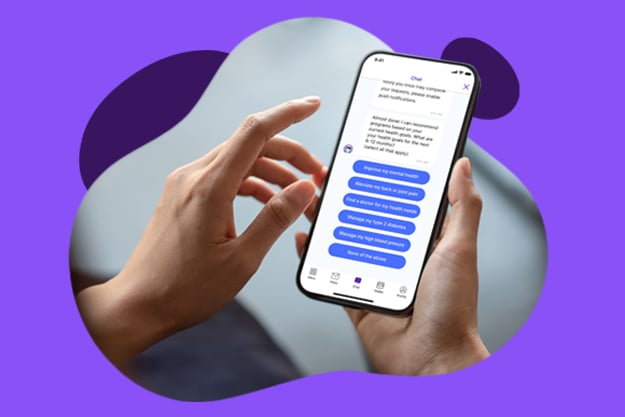How HealthJoy Gets in Front of Healthcare Decisions
For an employee, navigating the healthcare system is just a series of difficult decisions. With unclear pricing and confusing deductibles, it’s...
Connected Navigation Platform
Guiding to high-value care
Behavioral Health
Foster a mentally healthy workplace
EAP
Supporting holistic wellbeing
Virtual MSK Care
Reimagining musculoskeletal care
Virtual Primary Care
Powered by smart navigation
Surgery Centers of Excellence
Best-in-class surgical outcomes
Virtual Urgent Care
Immediate care, any hour of the day
Chronic Care
A new approach to chronic care
Integrations
Flexible to any strategy

When an employee takes family leave, there are many things HR needs to do along the way. There are legal guidelines you need to follow under the Family and Medical Leave Act (FMLA) if you have more than 50 employees in the United States – plus, additional non-legal steps HR can take to make life easier for the employees. All of these actions need to happen before, during, and even after your employee takes family leave. In this post, we break down what HR needs to do during every stage of the process.
Before your employee goes on leave…
Above all, have a solid family leave policy in place. Don’t wait until your first employee gives notice and scramble to create one. Otherwise, you risk confusion and potential liabilities. Your policy should cover the ins and outs of FMLA requirements, such as the 12 weeks of job-protected leave and group health benefits.
However, the other details of the policy are up to you. Will you offer paid or unpaid leave? Are there any policy differences for birthing parents versus adoptive parents? How far in advance does the employee have to give notice? These are essential points that you need to address in the family leave policy. Having everything laid out ensures everyone is on the same page.
HR may create the family leave policy, but it’s managers who enforce it. That’s why it’s necessary to provide managers with extensive training. It’s not only about teaching them how to handle FMLA time-off requests. It’s also about making sure they understand each employee’s rights and handle situations with sensitivity.
The last thing you want is a manager who inadvertently violates an employees’ rights or the law’s anti-discrimination provisions. For instance, if a manager doesn’t approve an employee’s request for leave (for the wrong reasons), this opens up the company to legal trouble. It’s also disrespectful to the employee and will create tense relationships. Save yourself the stress and invest in the training.
Having a seamless benefits experience is important, but especially so during a significant life event like pregnancy. Not knowing how to access insurance information quickly can be stressful for employees while they’re on leave. We recommend taking the time to sit down with them beforehand to walk through their benefits and answer questions. Also, make sure your employees have a way to access all the information even after they leave the office.
During your employee’s leave…
While your employee is on leave, be respectful, meaning zero work-related communications during their time off. You may think a single Slack message or email won’t hurt, but that can add a lot of burden to an already stressful situation. Not to mention it may breed resentment. You can decrease the chances of this happening by having a solid hand-off plan before your employee leaves.
Also, be aware of your employee’s privacy preferences. While some people are happy to hear from coworkers and share updates, others may want complete separation from work. Know what your employee wants and maybe wait for them to reach out first before making contact. It’s not personal; it’s just their way of handling the transition.
Be flexible around your employee’s family leave. For example, an employee may request a position change or a reduction in hours before and after parental leave. They may find that it’s challenging to work full-time during the late stages of pregnancy. Or they may want to work in a remote role to spend more time with their family.
While it isn’t required of the company to accommodate these changes, being flexible shows employees that you care about their needs. This, in turn, can lead to happier and more loyal workers. It may also end up working out better for the organizations and associated teams as well.
After your employee’s leave…
It can be intimidating to return to work after months of being away. Having a thoughtful transition plan in place can help ease some of your employee’s concerns. It shows them that they haven’t been forgotten and are wanted back at their jobs.
This plan can include information like major updates and which projects the employee will work on next. It can be helpful to map out goals for every week or month, so your employee knows what you expect of them during the transition. Make sure they have a support team that can answer questions and help them ramp back up more quickly as well.
Family leave doesn’t have to be all serious policies and work. It’s an incredibly exciting time for your employee – after all, they’re growing their family! When they return from leave, they should be welcomed back with open arms. This is an excellent opportunity to throw a party or present a thoughtful gift basket (preferably with lots of gift cards to buybuy BABY). Make sure you demonstrate to your employees that you’re there to support their family. Plus, celebrating as a team can strengthen your working relationship.
Make sure to cover all your bases when it comes to family leave. Start with the legal foundation and, from there, build out policies that suit your team’s needs. It’s not just beneficial for your company – it’s helpful for the employees as well.

For an employee, navigating the healthcare system is just a series of difficult decisions. With unclear pricing and confusing deductibles, it’s...

The post-pandemic return to work conversation stands at a strange tipping point. While some offices cautiously reopen, a surge in other states is...

With employment gains across all industries, the US economy saw 709,000 jobs created in December and November amid a surge in coronavirus cases. But...